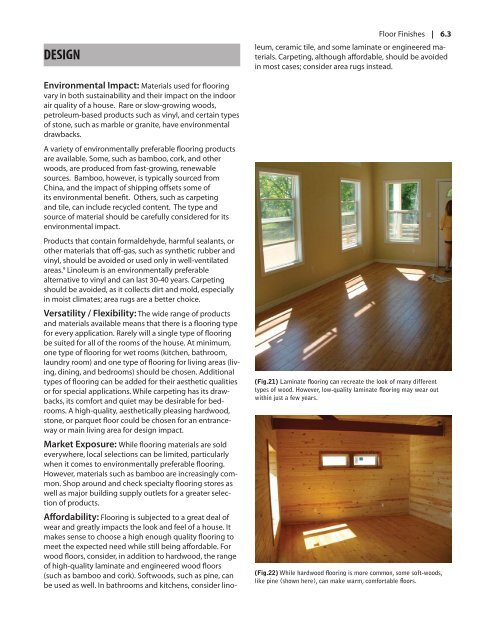Alternative Construction Research Guide - GCCDS
Alternative Construction Research Guide - GCCDS
Alternative Construction Research Guide - GCCDS
You also want an ePaper? Increase the reach of your titles
YUMPU automatically turns print PDFs into web optimized ePapers that Google loves.
DESIGNFloor Finishes | 6.3Environmental Impact: Materials used for flooringvary in both sustainability and their impact on the indoorair quality of a house. Rare or slow-growing woods,petroleum-based products such as vinyl, and certain typesof stone, such as marble or granite, have environmentaldrawbacks.A variety of environmentally preferable flooring productsare available. Some, such as bamboo, cork, and otherwoods, are produced from fast-growing, renewablesources. Bamboo, however, is typically sourced fromChina, and the impact of shipping offsets some ofits environmental benefit. Others, such as carpetingand tile, can include recycled content. The type andsource of material should be carefully considered for itsenvironmental impact.Products that contain formaldehyde, harmful sealants, orother materials that off-gas, such as synthetic rubber andvinyl, should be avoided or used only in well-ventilatedareas. 9 Linoleum is an environmentally preferablealternative to vinyl and can last 30-40 years. Carpetingshould be avoided, as it collects dirt and mold, especiallyin moist climates; area rugs are a better choice.Versatility / Flexibility: The wide range of productsand materials available means that there is a flooring typefor every application. Rarely will a single type of flooringbe suited for all of the rooms of the house. At minimum,one type of flooring for wet rooms (kitchen, bathroom,laundry room) and one type of flooring for living areas (living,dining, and bedrooms) should be chosen. Additionaltypes of flooring can be added for their aesthetic qualitiesor for special applications. While carpeting has its drawbacks,its comfort and quiet may be desirable for bedrooms.A high-quality, aesthetically pleasing hardwood,stone, or parquet floor could be chosen for an entrancewayor main living area for design impact.Market Exposure: While flooring materials are soldeverywhere, local selections can be limited, particularlywhen it comes to environmentally preferable flooring.However, materials such as bamboo are increasingly common.Shop around and check specialty flooring stores aswell as major building supply outlets for a greater selectionof products.Affordability: Flooring is subjected to a great deal ofwear and greatly impacts the look and feel of a house. Itmakes sense to choose a high enough quality flooring tomeet the expected need while still being affordable. Forwood floors, consider, in addition to hardwood, the rangeof high-quality laminate and engineered wood floors(such as bamboo and cork). Softwoods, such as pine, canbe used as well. In bathrooms and kitchens, consider linoleum,ceramic tile, and some laminate or engineered materials.Carpeting, although affordable, should be avoidedin most cases; consider area rugs instead.(Fig.21) Laminate flooring can recreate the look of many differenttypes of wood. However, low-quality laminate flooring may wear outwithin just a few years.(Fig.22) While hardwood flooring is more common, some soft-woods,like pine (shown here), can make warm, comfortable floors.
















